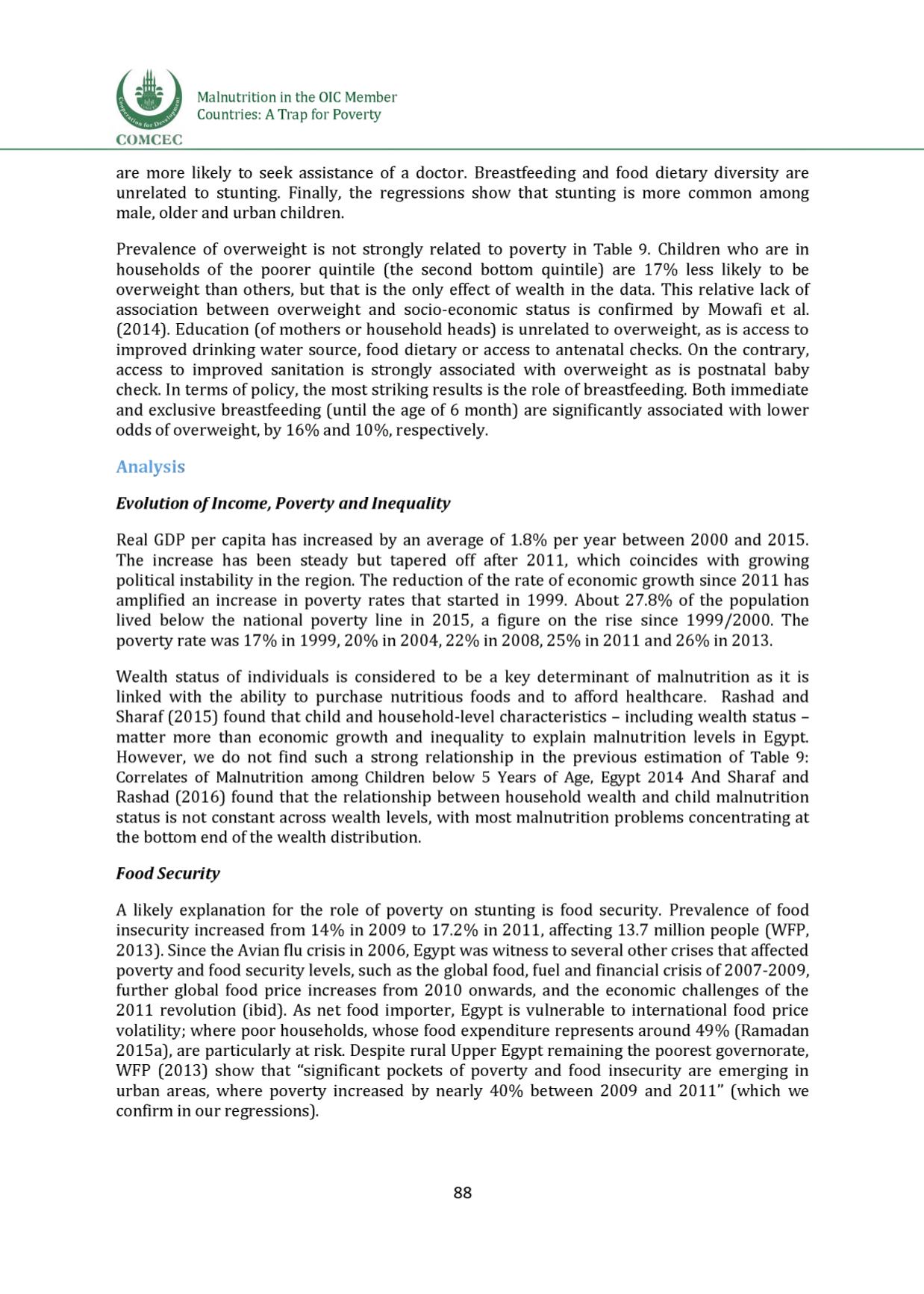

Malnutrition in the OIC Member
Countries: A Trap for Poverty
COMCEC
are more likely to seek assistance of a doctor. Breastfeeding and food dietary diversity are
unrelated to stunting. Finally, the regressions show that stunting is more common among
male, older and urban children.
Prevalence of overweight is not strongly related to poverty i
n Table 9. Children who are in
households of the poorer quintile (the second bottom quintile) are 17% less likely to be
overweight than others, but that is the only effect of wealth in the data. This relative lack of
association between overweight and socio-economic status is confirmed by Mowafi et al.
(2014). Education (of mothers or household heads) is unrelated to overweight, as is access to
improved drinking water source, food dietary or access to antenatal checks. On the contrary,
access to improved sanitation is strongly associated with overweight as is postnatal baby
check. In terms of policy, the most striking results is the role of breastfeeding. Both immediate
and exclusive breastfeeding (until the age of
6
month) are significantly associated with lower
odds of overweight, by 16% and
1 0
%, respectively.
Analysis
Evolution of Income, Poverty and Inequality
Real GDP per capita has increased by an average of 1.8% per year between 2000 and 2015.
The increase has been steady but tapered off after 2011, which coincides with growing
political instability in the region. The reduction of the rate of economic growth since 2011 has
amplified an increase in poverty rates that started in 1999. About 27.8% of the population
lived below the national poverty line in 2015, a figure on the rise since 1999/2000. The
poverty rate was 17% in 1999, 20% in 2004, 22% in 2008, 25% in 2011 and 26% in 2013.
Wealth status of individuals is considered to be a key determinant of malnutrition as it is
linked with the ability to purchase nutritious foods and to afford healthcare. Rashad and
Sharaf (2015) found that child and household-level characteristics - including wealth status -
matter more than economic growth and inequality to explain malnutrition levels in Egypt.
However, we do not find such a strong relationship in the previous estimation o
f Table 9: Correlates of Malnutrition among Children below 5 Years of Age, Egypt 2014 And Sharaf and
Rashad (2016) found that the relationship between household wealth and child malnutrition
status is not constant across wealth levels, with most malnutrition problems concentrating at
the bottom end of the wealth distribution.
Food Security
A likely explanation for the role of poverty on stunting is food security. Prevalence of food
insecurity increased from 14% in 2009 to 17.2% in 2011, affecting 13.7 million people (WFP,
2013). Since the Avian flu crisis in 2006, Egypt was witness to several other crises that affected
poverty and food security levels, such as the global food, fuel and financial crisis of 2007-2009,
further global food price increases from
2 0 1 0
onwards, and the economic challenges of the
2011 revolution (ibid). As net food importer, Egypt is vulnerable to international food price
volatility; where poor households, whose food expenditure represents around 49% (Ramadan
2015a), are particularly at risk. Despite rural Upper Egypt remaining the poorest governorate,
WFP (2013] show that “significant pockets of poverty and food insecurity are emerging in
urban areas, where poverty increased by nearly 40% between 2009 and 2011” (which we
confirm in our regressions).
88
















